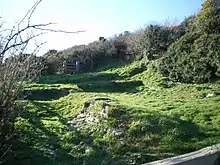Lammana Priory
Lammana Priory was a priory on Looe Island in Cornwall, UK, consisting of two Benedictine monks until 1289. It was owned by Glastonbury Abbey and the property was sold in 1289 to a local landowner.[1]

The Priory of St Michael of Lammana was a possession of the Benedictine monastery of Glastonbury Abbey during the Middle Ages. It consisted of two chapels; one on the top of Looe Island, and another chapel directly opposite on the mainland. A third building known as the Monk's House, located 150 yards down the hill from the mainland chapel, was the monks living quarters. It also had a refectory for pilgrims who came to visit the island for Michaelmas.
The earliest documentary evidence for the existence of the priory is a papal confirmation of Pope Lucius II in 1144. The confirmation (Privilegium) was made during the abbacy of Bishop Henry of Blois, the brother of King Stephen.
Some sixty years later, (c. 1199-1220) we have the charter of Hasculf de Soleigny, the lord of the manor of Portlooe, granting to the Church of the Blessed Virgin Mary of Glastonbury ... the Island of St Michael of Lammana, with all its appurtenances, lands, and tithes which they have held ab antiquo, 'from of old.'
Although not strictly a parish, it consisted of approximately 53 acres of tithe lands which ran from the edge of St Nicholas Church in West Looe, up West Looe Hill as far as the junction of Talland Road and then southwards to the manor of Portlooe, and downstream to a field known as Old Mills.
The ownership of tithes were the matter of a long standing dispute with the Augustinian canons of Launceston Priory, who acquired the parish of Talland early in the 13th century.
In about 1240-50, Richard Earl of Cornwall granted permission for Glastonbury to lease out the manor of Lammana, and on 24 June 1289, the patronage of the island chapel was sold to Walter of Treverbyn, lord of Portlooe.
The dispute over ownership once again returned, and Walter was forced to sue Launceston Priory for damages amounting to £40. In October 1290, the Sheriff of Cornwall was instructed to form a jury of twelve local men, who returned a verdict at the Court of Common Pleas, Westminster, in favour of Walter.
The chapels remained in use up until the dissolution of the monasteries in the reign of Henry VIII in mid-sixteenth century. Eventually they fell into disrepair, and by the mid-nineteenth century, apart from a few visible walls, became ruins.
The mainland chapel was excavated in 1935 and 1936, by Charles Kenneth Croft Andrew, antiquarian and archaeologist, with the support of his friend the Rev. Henry Ardern Lewis, M.A., then Vicar of Talland, and Mr C.B. Willcocks, F.R.I.B.A., F.S.A.
In 2008 Channel 4's archaeology series Time Team visited the island to carry out an investigation into its early Christian history. They excavated the sites of Christian chapels built on both the island and on the mainland opposite. During their dig they found the remains of a Benedictine chapel that was built in c.1139 by monks from Glastonbury Abbey, a reliquary, graves and the remains of much earlier Romano-British chapels built of wood with dating evidence suggesting use by Christians before the reign of Constantine the Great.
A hoard of eight Roman coins dating to about AD 253 - 60, were found on the third day of filming. Along with the neck of a Roman amphora, and an extremely rare bronze ingot found off the waters of Looe Island in 1984, they are clear evidence of long distance trade with the Mediterranean; lending weight to the recent suggestion that Looe Island may have been the fabled isle of Ictis mentioned by Diodorus Siculus.
References
- Orme, Nicholas (2007) Cornwall and the Cross. Chichester: Phillimore; pp. 30-31, 35, 38
Further reading
- Lewis, H. A. (1936) The Child Christ at Lammana: a legend of Looe and Talland; 2nd ed. (with suppt). [Falmouth: the author]